I've had an email recently from someone who says she is nervous about starting out on a new painting project. Over the years I've realised that this is a very common emotion - the fear of getting it wrong. Most students, and also many professional artists, encounter this on a regular basis. in our heads we think, "I really want to paint this picture, but what if it all goes wrong, what if I can't do it, what if I don't know how to do it...". These 'what ifs' can get so strong that sometimes they even stop us from putting brush to paper.
So what's the antidote? Well, I think it's, "Don't panic!" After all it's only a bit of paper (and that's even got two sides!), and a bit of paint. What's the worst that can go wrong? We waste some materials, and possibly hurt our pride a little. And even if it does go horribly wrong, we will still have learnt something. Yes, even a disaster teaches us something about how not to do it, and there may even be some really good bits mixed in with the mess!
So my advice is this, "Don't panic, don't listen to the 'what ifs' and pick up that brush!"
Thursday, 18 December 2008
Friday, 28 November 2008
Onyx Pencils
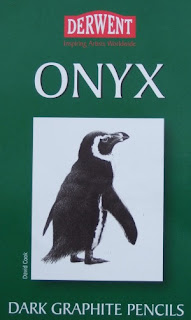 I've just been given a couple of the new Onyx dark graphite pencils made by Derwent Pencils to review. They have been developed as a one-size-fits-all type of pencil, that is each one can be used to make the lightest of marks and also the darkest of shades. The jet black tones they create are even darker than can be made with a soft 9B.
I've just been given a couple of the new Onyx dark graphite pencils made by Derwent Pencils to review. They have been developed as a one-size-fits-all type of pencil, that is each one can be used to make the lightest of marks and also the darkest of shades. The jet black tones they create are even darker than can be made with a soft 9B. 
Because you can make light and also very dark marks with the same pencil, you just need to take the one pencil out with you when sketching, instead of a small selection of 2H, HB, 2B and 6B. This obviously makes life a lot easier! Also, because they are made of a hard graphite, they don't wear down very much and they keep a sharp point for much longer than a softer dark pencil. It is therefore easy to make thin dark marks with these onyx pencils, unlike with say a 6B pencil that wears down very fast and looses its point.
So why not give them a go. You can get them from Derwent Pencils, or from your local art store.
Wednesday, 12 November 2008
Beautiful Paintings
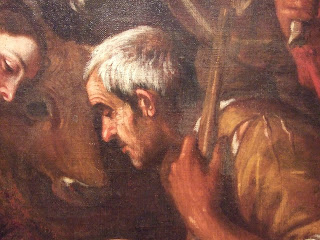
Here are a couple of details from two paintings I came across in the Museo de Bellas Artes in Murcia, Spain. They really caught my attention for different reasons and I managed to snap a couple of photos of them. I forgot to write down who they were by or what they were called, so apologies for that. I'd like to share them with you.
The first is from the 16th century and depicts the visit of the shepherds to the baby Jesus. I was struck by just how 'modern' the style of the painting looked, and how you could still see the individual brush-strokes. Most paintings of this time period had a much more polished appearance, and brush-strokes are hard to see, but in this wonderful painting they are still there, and you can see where the artist has brushed on his oil paint. It's an exciting connection to the past. Just look at the dry brush work on the man's head, and the light paint brushed loosely but so effectively onto his cheek. You can see each brush stroke and can imagine the artist all those hundreds of years ago reaching out his hand and adding them onto the canvas. I just love this sort of thing! I just wish I'd made a note of who he was...
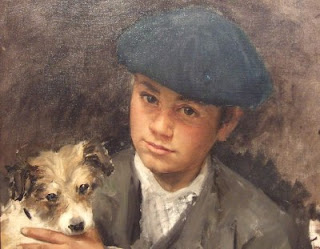 The second painting just grabbed me and held my attention for ages. I think it's the look in the boys eyes. Not many portraits look straight out at you, as it is deemed to be unnerving, but in this case the artist has so caught the tender expression in his eyes, and it is this that makes it such a powerful image. Again there is the connection with the past. You could be looking into the face of the real boy from a hundred years ago.
The second painting just grabbed me and held my attention for ages. I think it's the look in the boys eyes. Not many portraits look straight out at you, as it is deemed to be unnerving, but in this case the artist has so caught the tender expression in his eyes, and it is this that makes it such a powerful image. Again there is the connection with the past. You could be looking into the face of the real boy from a hundred years ago.What I also love about this painting is the contrast between the smooth skin of the boys face and the rough fur on the dog. That contrast alone adds so much to the painting.
I hope you enjoy looking at these two great masterpieces, and can maybe create a few of your own!!
Saturday, 1 November 2008
Painting Holiday in Spain
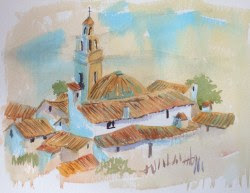 I've just returned to the UK from almost three months in Spain, which ended with leading a really enjoyable Painting Holiday in a small mountain village inland from Benidorm. We had a great week of sketching and painting in various locations, ranging from the brightly painted and colourful seaside town of Villa Joyosa, to the villages that cling to the mountains, and the ancient terraces of olive and orange groves surrounding our base at Relleu. Everyone seemed to have relaxed and painted well, and we were looked after superbly by our hosts who cooked delightful Spanish food all week.
I've just returned to the UK from almost three months in Spain, which ended with leading a really enjoyable Painting Holiday in a small mountain village inland from Benidorm. We had a great week of sketching and painting in various locations, ranging from the brightly painted and colourful seaside town of Villa Joyosa, to the villages that cling to the mountains, and the ancient terraces of olive and orange groves surrounding our base at Relleu. Everyone seemed to have relaxed and painted well, and we were looked after superbly by our hosts who cooked delightful Spanish food all week.
You can find out more details and see some of the photos by clicking on the Painting Holidays link on my website. I'm now booking up for another one in June 2009, so please let me know if you'd like to come along.
Monday, 29 September 2008
Ways with Colour
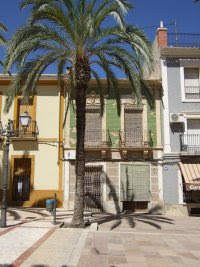 I visited a small village called Hondon de los Nieves a while ago, and did some sketching and took some photos of the colourful Spanish houses there. Yesterday I thought I'd play around with some of these photos and see what I could paint from them.
I visited a small village called Hondon de los Nieves a while ago, and did some sketching and took some photos of the colourful Spanish houses there. Yesterday I thought I'd play around with some of these photos and see what I could paint from them.I chose one and then zoomed in and cropped it on the computer to produce a composition I liked. These windows were full of character and I loved the palm tree running up through the picture and the fronds just poking in from above. The lamp made another interesting feature. All in all there was plenty to have a go at.
I used watercolours to paint the first version using the greens and cool colours that were in the photo, and really enjoyed doing it. But then I thought I'd have a go at using a different warmer colour set, so I painted another version using
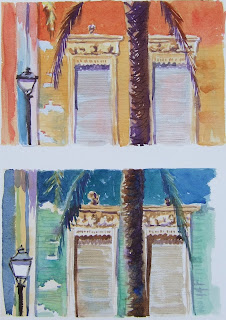 oranges, reds and golds. (One reason for this is that my wife wants me to do a large oil painting for the living room and this needs to be in oranges to fit the decor - I can't believe I'm painting to fit the decor!!).
oranges, reds and golds. (One reason for this is that my wife wants me to do a large oil painting for the living room and this needs to be in oranges to fit the decor - I can't believe I'm painting to fit the decor!!).Another reason for the colour change was to break away from painting things 'as they are' and to experiment more with creating art, and a third reason is that paintings in warm colours outsell paintings in cool colours by a major factor.
So I've three questions for you. Which do you like most? Do they have a different emotional pull? And have you ever tried painting the same scene in different colours? Why not give it a go - it's a fascinating experiment.
Friday, 19 September 2008
Sunny Spain Part 2
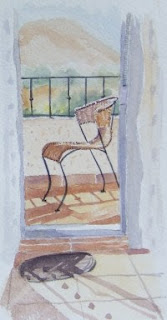
Well I've found out some of the answers to the questions I had in my last post. The temperatures have been pretty high in the last few weeks, around 33c in the shade and up to 45c in the full sun. My watercolours dried and cracked up in the pans and I thought they were ruined, which was going to cause me problems with the painting holiday coming up at the end of October. However I left them to soak in warm water overnight, and lo and behold, the next day they were fine! I can't tell you how relieved I was to be able to use them again. (It's not easy getting art materials in Spain.)
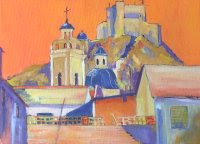 And there are even some advantages to the dry heat. I have had a go at a couple of oil paintings, using acrylics for the under-painting, and boy, these acrylics dry fast! Which means I can almost immediately get on and paint on top of them with the oils, which also then dry to the touch within a day or two. So, no more wet oils hanging around the house for weeks. My wife will be ever so pleased!
And there are even some advantages to the dry heat. I have had a go at a couple of oil paintings, using acrylics for the under-painting, and boy, these acrylics dry fast! Which means I can almost immediately get on and paint on top of them with the oils, which also then dry to the touch within a day or two. So, no more wet oils hanging around the house for weeks. My wife will be ever so pleased!
Wednesday, 3 September 2008
Spanish Sun
I've just arrived in Spain with my lovely wife and we are here for two months as a prelude to moving out permanently in January '09. The sun is shining and it's very hot (over 30 c in the shade and up to 45c in the full sun), which is in such direct contrast to the UK where it had been raining and cold through the whole of the summer months.
It's going to be interesting learning to paint in this climate - my watercolours will dry quicker, and goodness knows what the heat will make of my acrylics... I've brought watercolours, acrylics, water soluble oils and coloured pencils with me to see how things work out. I'm so used to needing a hair dryer to speed up drying times back in the Lake District. Maybe I'll just need to paint faster!
There is still a little room on the course I am leading in October here in Spain, so if you have a week to spare and want some winter sunshine, then why not join me. Details are on the website.
It's going to be interesting learning to paint in this climate - my watercolours will dry quicker, and goodness knows what the heat will make of my acrylics... I've brought watercolours, acrylics, water soluble oils and coloured pencils with me to see how things work out. I'm so used to needing a hair dryer to speed up drying times back in the Lake District. Maybe I'll just need to paint faster!
There is still a little room on the course I am leading in October here in Spain, so if you have a week to spare and want some winter sunshine, then why not join me. Details are on the website.
Wednesday, 20 August 2008
Just Pick 2
Here’s an idea I came across recently that I thought you might like. It’s a way of getting around ‘painter’s block’ which is a bit like writer’s block, only worse! This is when you just don’t know what to paint, or how. And it strikes every artist every now and again.
So here’s what you can do to get those creative juices flowing again. Pick a subject – any subject. It doesn’t really matter what. It could be a landscape, a photograph, an object from your house, just anything. And then think about how you can draw or paint it using just two from the following list: line, tone (value), colour, texture, atmosphere, blocking in solid colour, using different materials.
So for instance, paint a vase concentrating on using lines and textures; or paint a landscape using just blocked in solid colours and tones. This will force you to look at, think about and paint the subject in an entirely different way to usual and should undo that creative block.
So here’s what you can do to get those creative juices flowing again. Pick a subject – any subject. It doesn’t really matter what. It could be a landscape, a photograph, an object from your house, just anything. And then think about how you can draw or paint it using just two from the following list: line, tone (value), colour, texture, atmosphere, blocking in solid colour, using different materials.
So for instance, paint a vase concentrating on using lines and textures; or paint a landscape using just blocked in solid colours and tones. This will force you to look at, think about and paint the subject in an entirely different way to usual and should undo that creative block.
Tuesday, 12 August 2008
Painting Ideas Webpage
Have you had a look at the Painting Ideas page on my website yet? I'm slowly adding new ideas to it, and have just put on a couple of websites that you might like to visit. One is the Painters Online site that is run by the UK magazines The Artist and Leisure Painter, and the other site is a gallery with lots of video content. I think you'll find both of them interesting!
Wednesday, 6 August 2008
Wildlife Artist of the Year
Tuesday, 5 August 2008
The Zorn Palette
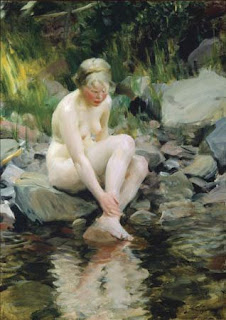
I recently came across what is known as the Zorn palette, which consists of just yellow ochre, cadmium red, ivory black and white. Now whether Anders Zorn ever used this palette of colours is debatable, but it has been attributed to him. (Anders Zorn (1860-1920) was possibly Sweden’s best known artist and he specialised in painting portraits and nudes. I have used one of his charcoal sketches as inspiration for one of the projects in my online drawing course).
So I thought I’d have a go at using these four oil colours, but actually had a bit of trouble getting any kind of blue out of the ivory black. The theory is that by placing a grey made from the black and white next to an orange made from the red, yellow and white, the orange will make the grey look bluish. This is because the eye picks up the orange and then ‘invents’ the complementary blue colour. However I just couldn’t get it to work. I just got grey!
But this got me thinking about just using three colours for painting (plus white if you are using oils or acrylics). There’s an American oil painter called Kevin MacPherson who paints outdoors a lot, and uses just cadmium red, Cadmium yellow, ultramarine blue and white, and with these he creates every colour he could possibly need, and all with great harmony!
So why not pare down your paints to just these four and have a go at mixing everything else. See what you can come up with.
Monday, 28 July 2008
Painting Vacation in the USA

Are you looking for a quite and beautiful place to paint for a week or two? Then why not look at this property sent to me by a course member, which is available as a house swap. Its at Jamestown, Rhode Island, USA and is a New England seaside hideaway. If you are an artist, a writer, a globe trotter, or just an escapee from any big city you will find inspiration and enjoy island living in this shingle-style, seaside cottage. For more information, go to http://www.homeexchange.com Listing ID 95348
Friday, 25 July 2008
Summer sketches make winter paintings
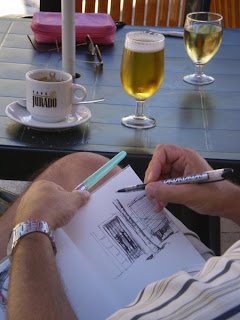 Summer is such a good time to get out and about with your paints and sketchbook. We get so locked indoors in the winter months because of the weather, and it’s good to use the warmer and drier summer months to go outside and collect material to use in the winter days. If you sketch as well as take photographs, you will soon build up a wonderful resource that will spark off ideas from which to paint.
Summer is such a good time to get out and about with your paints and sketchbook. We get so locked indoors in the winter months because of the weather, and it’s good to use the warmer and drier summer months to go outside and collect material to use in the winter days. If you sketch as well as take photographs, you will soon build up a wonderful resource that will spark off ideas from which to paint.So my advice this month is this – take a small pad and a pencil with you wherever you go, and sketch anything that you see of interest. If you can manage it, keep a small watercolour paint box and a couple of brushes in the car so that you are always ready to paint a quick scene. It doesn’t have to take more than a few minutes to capture the essence of a building, a landscape, a group of children playing, or whatever it is that has caught your attention. And who knows what masterpieces these sketches will inspire in the winter months to come!
Saturday, 19 July 2008
Credit Crunch
The downturn in the economy in the USA and in Britain is hitting us all hard. I've certainly noticed a big decrease in the number of people singing up for my online courses, and this is very unusual in the 31/2 years I've been running them. Money is just getting tight, and I suppose that art courses are one of those non-essential expenses that go first when folks tighten their belts.
However I've always tried to keep the courses at a reasonable price (there are some very expensive courses out there!), and I hope that this will continue to attract people to sign up for them. I've even now reduced the price of the watercolour course for anyone signing up for news and info. So, even though times are tough, let's not let it get us down, and let's cheer ourselves up by getting out those pencils and paints and enjoying our art.
However I've always tried to keep the courses at a reasonable price (there are some very expensive courses out there!), and I hope that this will continue to attract people to sign up for them. I've even now reduced the price of the watercolour course for anyone signing up for news and info. So, even though times are tough, let's not let it get us down, and let's cheer ourselves up by getting out those pencils and paints and enjoying our art.
Monday, 30 June 2008
Derwent Pencils winter courses

I live in Keswick where the Derwent Pencil factory has been for many years and where the pencil as we know it was first invented and mass produced. The company now produces a whole range of graphite and coloured pencils and have asked me if I would like to do a couple of demonstration days for them in November and December this year. So I'm now playing around with some nice new sets of coloured pencils that I've been given to test out (watercolour pencils and inktense). It's great fun to be able to do this, and I am not only planning how to teach on those days, but I am also taking the opportunity to work on a new short online course for coloured pencils. This will add on to the end of the drawing course, or can be taken in isolation. So look out for this if you are interested, or even join in on one of the winter courses at the Pencil Museum in Keswick.
Monday, 16 June 2008
Musical Painters - your comments please!
Here's a question for you? Do you listen to music when you paint, or do you prefer silence? And if you do listen to music, what type of music do you listen to? Does it inspire you, relax you, or energise you as you paint? I'd love to find out.
You can add your comments by just clicking on the 'comment' link below this article. In fact you can comment on any of my articles - I'd love it if you did.
I have to say that I usually paint without music, but that is simply because I forget to put it on! In the past I have listened to classical music while painting and did find that my brush moved in time to the music!
You can add your comments by just clicking on the 'comment' link below this article. In fact you can comment on any of my articles - I'd love it if you did.
I have to say that I usually paint without music, but that is simply because I forget to put it on! In the past I have listened to classical music while painting and did find that my brush moved in time to the music!
Tuesday, 20 May 2008
Pick a Picture
Following on from my last entry, My Inspirations Box, I have noticed that when I take this box to my art class, my students will root through it looking for something to inspire them. But what is fascinating is to see which pictures they choose. Out of perhaps 100 or 150 paintings, they will regularly pick the same dozen or so pictures.
So why these paintings, and not the others? Well, for some it is the boldness of the colours (people tend to be like butterflies - attracted to bright colours!), whilst for most it is the composition and especially the tonal composition of the painting. The students may not be able to put it into words why they like a certain painting, but it is almost always a strong tonal value contrast that draws their eye and inspires them. This is the hidden secret of many a great painting. If you get the tonal composition right, then people will be attracted to the painting. Good strong tones produce good strong paintings.
As a plug, you can find out more about this in my online watercolour course.
So why these paintings, and not the others? Well, for some it is the boldness of the colours (people tend to be like butterflies - attracted to bright colours!), whilst for most it is the composition and especially the tonal composition of the painting. The students may not be able to put it into words why they like a certain painting, but it is almost always a strong tonal value contrast that draws their eye and inspires them. This is the hidden secret of many a great painting. If you get the tonal composition right, then people will be attracted to the painting. Good strong tones produce good strong paintings.
As a plug, you can find out more about this in my online watercolour course.
Wednesday, 7 May 2008
My Inspirations Box
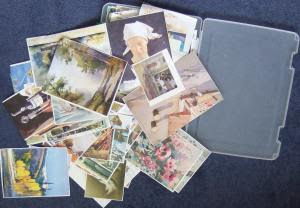
Are you ever stuck for something to paint? Or do you need inspiration to find a new style or way of painting? Then this may be the answer!
I call it my Inspiration Box, and it is full of paintings that I have cut out of art magazines. There are paintings here that I like, and others that don't particularly appeal at the moment (but may be just the thing in time to come). There are paintings that are very detailed, and others that are painted very loosely; there are oils, watercolours, pastels and acrylics, pencil drawings and pen & wash. There are portraits, landscapes, still life and abstracts. Some are brightly coloured and others almost monochrome. I could go on, but I'm sure you've got the idea...
Now, when I get stuck for a subject, or just want to try a new way of painting, I go to my Inspirations Box and dig through it. I am assured of finding something that will get my creative juices flowing - either by directly copying a painting (you can learn so much by doing this!), sketching ideas from it to create my own new painting, or using the style of painting in a new composition of my own. Ans some days it is just enough to open the box and look at all the pictures over a long cup of coffee. To me it is like listening to soothing music. Aaaaah, it must be good for the soul!
Friday, 25 April 2008
When is it finished?
I remember watching a video a number of years ago of the celebrated oil painter Fred Cuming RA. It was a sort of masterclass, and he was painting an estuary scene from scratch. It was wonderful to watch him layering on thick oil paint with such confident strokes of the brush as the painting developed. After a while he had created what I thought was a great scene, with just enough detail to define the ebbing water, the decaying wooden fence posts, and the evening light. It was to me the perfect picture.
But then he mumbled something at the camera and wiped a whole portion off the canvas and started again. I wanted to shout "NO! Don't do it! You had the picture there!". But he repainted and wiped away and repainted again until he was satisfied that the painting was what he wanted. I think he must have had a certain quality of light, or mood, or something in his mind that he wanted to catch. (But I still think the earlier version was better!)
Knowing when to stop is really a matter of opinion, and the end result has to be what you, the artist, is striving to achieve. It didn't matter to Fred on his video, that I wanted him to stop earlier. He knew what he wanted to achieve, and to him, he achieved it. The satisfaction was his, and he must have learned something that day. I know I did!
You can see some of Fred Cuming's work at his website (http://www.fredcuming.com/)
But then he mumbled something at the camera and wiped a whole portion off the canvas and started again. I wanted to shout "NO! Don't do it! You had the picture there!". But he repainted and wiped away and repainted again until he was satisfied that the painting was what he wanted. I think he must have had a certain quality of light, or mood, or something in his mind that he wanted to catch. (But I still think the earlier version was better!)
Knowing when to stop is really a matter of opinion, and the end result has to be what you, the artist, is striving to achieve. It didn't matter to Fred on his video, that I wanted him to stop earlier. He knew what he wanted to achieve, and to him, he achieved it. The satisfaction was his, and he must have learned something that day. I know I did!
You can see some of Fred Cuming's work at his website (http://www.fredcuming.com/)
Monday, 21 April 2008
April Painting Holiday
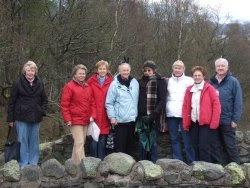
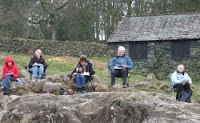
If you happened to be out and about in the hills around Keswick in the Lake District last week you may have come across a group of slightly frozen artists. I had eight delightful painters with me for a week of sketching and painting in the Lake District, and every day we managed to get out into the countryside despite the biting wind. I think they all deserve some kind of medal for bravery! We had many laughs along the way, and really enjoyed each other's company as we had a go at painting this beautiful and slightly over-awing scenery. My thanks to all who took part in making this such a memorable week.
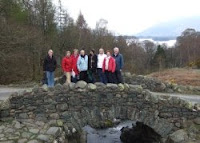
I remember painting in even colder weather once, when my paint froze on the paper before it had a chance to dry, and ice crystals appeared in the paint box. I've heard that you can prevent this by adding gin to your water - but that seems to me to be a bit of a waste!
Saturday, 12 April 2008
Drawing on the Masters
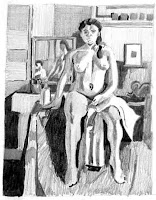
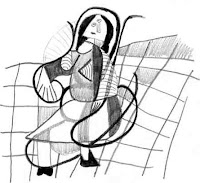
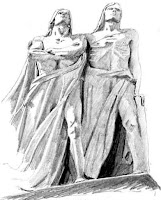
Recently I was down in Brighton for a week and I took my drawing kit and a couple of photos to work from with me (England is cold at this time of year and I didn't expect to get out much!) I was staying at my mother-in-laws house and she has a good collection of drawing and painting books left behind by my father-in-law who was also an artist.
Flicking through them I realised how much I could learn by copying some of the paintings in pencil, as I didn't have any paints. It was a good exercise in seeing and drawing tones and textures, and learning as I went along how the masters before us were able to construct such wonderful pictures. Here are just a couple of examples - Carmelina by Henri Matisse and, by way of contrast, Lady in a Rocking Chair by Pablo Picasso.
Inspired by these I then worked from a photo I had taken in Northern France a few years ago of the massive statues at the Canadian war memorial. I've called them Brothers in Arms after the Dire Straits song.
A handy tip - if you draw in pencil and don't want your masterpiece smudged afterwards, just spray it with a cheap hairspray to fix it. You can even spray it as you go along and still draw on top of it. Much cheaper than the fixer you buy at an art shop, and just as good!
Friday, 28 March 2008
Bring life to dull photos

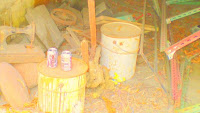
I am indebted to my wife, Donna, for this tip. She uses the free google photo handling software called Picasa (download it free from http://picasa.google.com/), which not only sorts your photos into one easy to use place, but also has lots of fixes, tunings and effects that you can apply to your photos. So I began to play with it to see what it could do.
I chose a photo that didn't show much promise as something to paint from. It was of some rusty bits of junk in an old shed - all darks and rust browns and not terribly exciting. But by fiddling around with it in Picasa I managed to brighten it so the objects hidden in the dark could be seen, and enhanced the colours, so that browns turned into greens, reds, oranges and yellows, and then I sharpened it and cropped it as well. The end result was a photo with much more interest in it, and something that could be used to make a painting (possibly as an abstract).
So, find some of your most boring photos and have a go with a programme such as this and see what you can do. You may not even use the photos in the end to paint from, but the process of changing them may spark off other ideas that may inspire your painting.
Wednesday, 19 March 2008
Pick a Theme
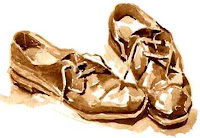
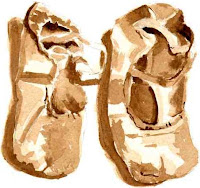
Do you sometimes get painters' block? That's when you are really inspired to paint, and all you want to do is to put brush to paper, but you can't think of a subject. You look around for ages, and nothing seems to grab you, and eventually after half an hour of wandering around in ever decreasing circles, you just give up, pack your painting gear away and sit and watch the TV! This is what is called painters block.
So how about choosing to paint the first thing you come across? Whatever it is. If you are indoors then it might be the computer, or a mug of tea, or the sofa. If you are outdoors, don't spend ages looking for the perfect view, just paint the first thing you see - perhaps a bit of bark, or some rusty furniture, or a cow. Too much precious painting time can be wasted in looking for the 'right' scene.
And you may find that once you have found a subject then there may be other similar subjects lying around. I chose to paint a pair of leather shoes. (To make life easier I painted them in monochrome, using only burnt sienna and burnt umber.) They were quick studies and were very enjoyable to have a go at. And when I had painted the first pair, I then decided that this was a good theme, and found the second pair, the ballet shoes. Now if I should get painters block again sometime soon, I know that I will be able to just pick another pair of shoes and paint away. And perhaps then move on to hats, or coats or even underwear! I need never be stuck for a subject again.
Wednesday, 12 March 2008
Simple Subjects

Sometimes it is the simplest of subjects that make the best paintings. We can spend a lot of time looking for the best view, or the most unusual set-up, or the most detailed of designs, and in so doing we can miss the simple subjects that are all around. This farmhouse in the Lake District is not complicated at all, and yet on the morning I painted it, it was almost magical. The cool spring sun was lighting it up beautifully against the dark wooded hillside, and the simple shape of the building just made a lovely composition. So next time you are stuck for something to paint, just look for the ordinary subjects, and then make them extra-ordinary!
Saturday, 1 March 2008
Sketching from Photos
If you find that you can't get out much because the weather isn't good, and you are wondering "what shall I draw?", then why not have a go at this exercise. Get a sketchbook and pencil or pen, and find some photos on your computer. Then give yourself just 5-10 minutes to sketch the photo into your book, just as if you were doing it outside with the view in front of you. By taking just a short time you will be forced into just getting the main elements down, and your sketchbook will soon fill up with fresh looking pictures that you can use for inspiration when you come to paint.
The joy of spring
Spring is just beginning here in the UK, and it is great to see the buds breaking on the trees, the daffodils in the garden, and the longer days. I shall be out sketching soon, as things warm up. As the seasons change through the year, so does the landscape and the garden. There will be new colours and shapes emerging all the time. If you want a challenge then try to paint or sketch a diary throughout the year capturing these things!
The Quick Draw
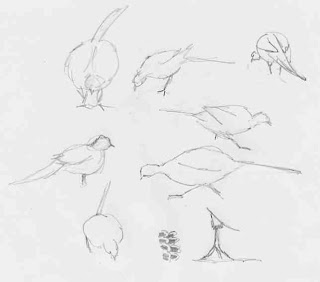
We have a dozen or so pheasants that have recently decided to visit our garden every day. They've become quite tame and are great fun to watch as they peck around the garden after seeds. So this morning I could resist it no longer, and just had to get the sketchbook out. The problem is, the pheasants don't stay in one position for more than two seconds at a time. They are constantly on the move. So my pencil sketches had to be very quick indeed, just a few seconds each, trying to catch something of the overall shape and movement of the birds.
So why bother if that's all the detail you can get? Well, to my mind, it is invaluable to sketch like this. Firstly it forces you to study and memorise your subject in a flash, and secondly it helps you to become loose and unfussy with your drawing -just capturing the few basic lines that are needed to show what it is. I think your drawing skills are honed by spending a few moments a day sketching something like these moving birds.
Saturday, 23 February 2008
Royal Society of Portrait Painters
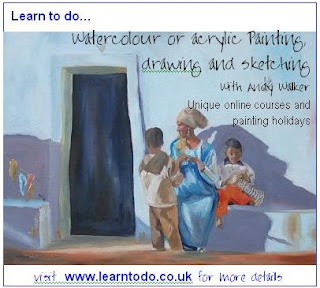
I've been invited to advertise in the 2008 catalogue for the Royal Society of Portrait Painters exhibition which is held at the Mall Galleries in London. Here is the advert for you to see; I painted this scene in oils from a photo I took in Egypt last year.
Why not go along and enjoy the superb paintings at the exhibition when it comes around (from April 25th to May 12th 2008).
The website of the Royal Society of Portrait Painters can be found at http://www.therp.co.uk/
Wednesday, 20 February 2008
Reflections of Venice
Venice is a fas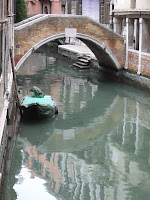 cinating city, full of hidden passageways that meander between tall buildings that blot out the sky, and in which you get frequently lost. Then, rounding a bend you suddenly find yourself crossing one of those wonderful foot bridges that we've all seen in paintings and photos, angular on top and arched below, and spanning the dark green waters of a canal or rio. There are more of these bridges than you can count, and sailing silently between them are jet black gondolas, only just rippling the water as they pass by.
cinating city, full of hidden passageways that meander between tall buildings that blot out the sky, and in which you get frequently lost. Then, rounding a bend you suddenly find yourself crossing one of those wonderful foot bridges that we've all seen in paintings and photos, angular on top and arched below, and spanning the dark green waters of a canal or rio. There are more of these bridges than you can count, and sailing silently between them are jet black gondolas, only just rippling the water as they pass by.
The Grand Canal is another majestic sight, and one which is all too familiar from paintings. It is beautiful, (but daunting to paint), and is edged with a multitude of crumbling buildings, doorways and arches, that grow vertically out of the water.
But what really makes Venice are the reflections. The water literally adds a whole new dimension to the city, and the buildings and bridges are all reflected downwards, so you get twice as much to look at and paint!
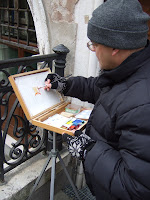
I went to Venice for the first time in February 2008, ( a 50th birthday present from my wife), and I took along all my painting gear. The problem was, it was bitterly cold and almost impossible to stay still for more than a few moments without freezing, so I didn't manage to get much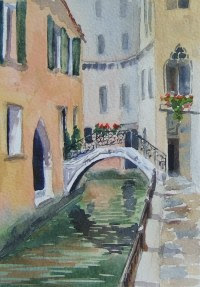 painting done. However I do have over 150 photos to work from in the warm comfort of my studio. Here's my first attempt .
painting done. However I do have over 150 photos to work from in the warm comfort of my studio. Here's my first attempt .
 cinating city, full of hidden passageways that meander between tall buildings that blot out the sky, and in which you get frequently lost. Then, rounding a bend you suddenly find yourself crossing one of those wonderful foot bridges that we've all seen in paintings and photos, angular on top and arched below, and spanning the dark green waters of a canal or rio. There are more of these bridges than you can count, and sailing silently between them are jet black gondolas, only just rippling the water as they pass by.
cinating city, full of hidden passageways that meander between tall buildings that blot out the sky, and in which you get frequently lost. Then, rounding a bend you suddenly find yourself crossing one of those wonderful foot bridges that we've all seen in paintings and photos, angular on top and arched below, and spanning the dark green waters of a canal or rio. There are more of these bridges than you can count, and sailing silently between them are jet black gondolas, only just rippling the water as they pass by.The Grand Canal is another majestic sight, and one which is all too familiar from paintings. It is beautiful, (but daunting to paint), and is edged with a multitude of crumbling buildings, doorways and arches, that grow vertically out of the water.
But what really makes Venice are the reflections. The water literally adds a whole new dimension to the city, and the buildings and bridges are all reflected downwards, so you get twice as much to look at and paint!

I went to Venice for the first time in February 2008, ( a 50th birthday present from my wife), and I took along all my painting gear. The problem was, it was bitterly cold and almost impossible to stay still for more than a few moments without freezing, so I didn't manage to get much
 painting done. However I do have over 150 photos to work from in the warm comfort of my studio. Here's my first attempt .
painting done. However I do have over 150 photos to work from in the warm comfort of my studio. Here's my first attempt .
Tuesday, 19 February 2008
Above the clouds

I've just flown to Venice from the UK, and as the plane cruised through the cloud layer I was reminded of the first time I ever flew and saw the clouds from above. What an amazing sight; a sea of white rolling waves lit by the setting sun. It was truly inspiring!
This time there was not only the creamy blanket of cloud, but also the sparkling white snow- covered peaks of the Alps punching through it, and once again I was awed. It is scenes like this that inspire me to paint. New sights excite me.
Whenever I visit a new place I find I am seeing through fresh eyes, and suddenly there are hundreds (if not thousands) of things to paint. It is almost as if the change of light, of architecture, colours and people, invite and challenge me to paint them. It is always easy to get the sketch book out in a new place.
But what about back at home? Do I get as excited about painting the familiar things around me? Perhaps I should be looking at the everyday objects, the familiar streets, and the things that surround me with fresh eyes. For what is 'ordinary' and perhaps 'boring' to me would be exciting and stimulating to someone from another place. So I suspect it's time to look around my home town again and get the paints out!
Thursday, 14 February 2008
The Watercolors of John Singer Sargent
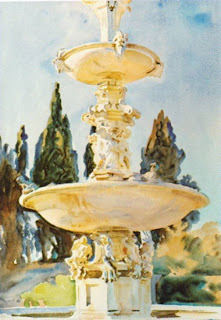
I've just bought a wonderful new book on the watercolours of John Singer Sargent, who was painting around the turn of the 20th century, mostly in Europe. I have to say they are absolutely tremendous. He had a style that was very free and simple and many of his paintings are composed of fresh and creative brush marks that just about describe what he is painting, but no more. There is just enough information to let the viewer know what the subject is, but with plenty of room left for the imagination. And his colours are clear, crisp and clean! You can feel the sunshine, the turbulence of the rushing river, and the stillness in the woods.
When I buy books like this from leading artists I like to have a go at copying their style. There is so much you can learn from copying the masters (and after all that is how artists have learned to paint down through the centuries). So in the coming weeks I'll choose a painting from the book that inspires me, try and work out how he painted it, and then have a go myself. It's a great way to learn!
Tuesday, 12 February 2008
New watercolour module
Over this last weekend (7th Feb '08) I've added a new landscape module to the end of the watercolour course, which is very exciting. It's taken me a bit longer than I thought to write, as various other commitments kept getting in the way, but after 6 months or so it was finally ready to publish. There's been a great response to it (thank you if you bought it!), especially from people who have taken the course over the last few years.
The idea for the module came from several people emailing me at the end of the watercolour course and asking for more lessons. They were sad that the course had come to an end after 32 issues and were looking for some sort of follow on material. So the idea for the landscape module came about. In the next year I want to write a colour & design module, and maybe later on a still life module, which will both continue on from the watercolour course. So look out for these, and sign up for the news-and-info mailings from me so that I can keep you in touch (you can sign up for these from the website at www.learntodo.co.uk).
The idea for the module came from several people emailing me at the end of the watercolour course and asking for more lessons. They were sad that the course had come to an end after 32 issues and were looking for some sort of follow on material. So the idea for the landscape module came about. In the next year I want to write a colour & design module, and maybe later on a still life module, which will both continue on from the watercolour course. So look out for these, and sign up for the news-and-info mailings from me so that I can keep you in touch (you can sign up for these from the website at www.learntodo.co.uk).
Subscribe to:
Posts (Atom)


